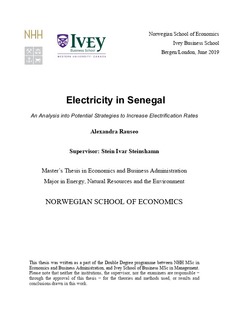| dc.description.abstract | Senegal is a West African country dependent on imported fossil fuels for power generation.
The population of Senegal is 15.85 million, with the urban and rural electrification rates at
87.7 and 38.3, respectively. Over half of the population lives in rural areas with limited to no
access to electricity. Across the country the demand for electricity is increasing at a rate of 6.2
percent per year indicating a need to increase energy production and rural electrification rates.
The objective of this paper was to analyze the potential renewable energy sources and
determine the best method for increasing electrification in Senegal. These energy sources
include solar, wind, biomass and hydro power. The physical and economic potential for each
source was calculated to evaluate its potential in Senegal. The levelized cost of electricity was
determined for these sources and used to compare them to each other and with historic values
for natural gas, coal, and diesel. Additionally, the benefits and challenges for each source were
discussed and potential strategies for increasing the electrification rates in Senegal were
evaluated using an evaluation matrix.
The results in this paper were used to identify methods to reduce dependence on imported
fossil fuels and increase electrification rates, especially in rural areas in Senegal. The current
dependence on imported fossil fuels subjects Senegal to unstable market conditions and
negative environmental effects, thus the focus of this paper was on renewable energy sources.
From the analysis completed in this paper, it was identified that Senegal could diversify its
energy portfolio through a mix of solar, wind, biomass, and hydro power investments. Solar
power was identified as the best method to increase electrification rates in rural locations
without access to the grid. Wind, biomass, and hydro power were determined to have
significant potential in Senegal but would require access to the national grid or an isolated
system to distribute power. The levelized cost of electricity for the renewable energy sources
analyzed were within the historic range of levelized costs for fossil fuels. | nb_NO |
